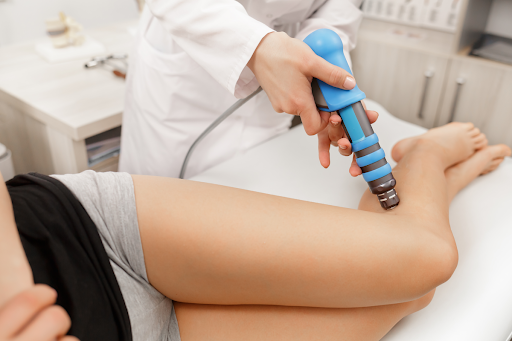You may have heard of shockwaves when it comes to earthquakes, but did you know they can be used in medical treatments as well?
Focused shockwave therapy, originally developed to treat kidney stones, is used to treat skeletal and muscular pain throughout almost every part of the body. Injuries, including tennis elbow and plantar fasciitis, occur because of strain, overuse, or damage to the musculoskeletal system. This system is responsible for your body’s mobility, meaning any damage it sustains can be highly serious.
Using focused shockwave therapy can greatly enhance the healing process in muscles, bones, and connective tissues and help them recover. However, what are the shockwave effects on the body that make the treatment possible? To learn more, here’s an overview of the shockwave procedure and how it affects the human body to promote healing.
Shockwave Effects on the Body
Prior to the procedure, an ultrasound gel is commonly applied to the skin of the patient to facilitate the transmission of the shockwaves. Additionally, the shockwaves used in the therapy aren’t electrical but lower energy sound waves that can penetrate the skin and reach the injured tissues. When the acoustic waves reach the affected area, they enhance the healing process in a variety of ways.
During the shockwave procedure, a device is used to send shockwaves directly to the injured area. The shockwave effect will deliberately cause inflammation in the targeted region to increase the blood flow in the area. Nutrients and oxygen, which are essential components of the repair process, will reach the damaged tissue faster because of the increased flow of blood. As a result, the natural recovery process is quickened and the individual will heal faster than they otherwise would have.
Using focused shockwave therapy also stimulates collagen production. This protein is used to build and repair multiple parts of the body, including the connective tissue. The shockwave effect will alter the structure of collagen fibers to become denser, allowing ligaments and other skeletal features to become stronger.
Shockwaves will also destroy certain cells that can impair the recovery process. For example, scar tissues, which aren’t elastic and reduce mobility, can be broken down by focused shockwave therapy, restoring mobility to the affected area or tissue.
Additionally, the shockwave effect is also able to reduce pain in certain ways. When C nerve fibers are activated, they release a neurotransmitter called Substance P. This substance transmits pain signals and can cause discomfort. However, shockwaves are able to prevent C nerve fibers from releasing Substance P through continued activation and reducing their concentration.
How The Body Is Affected After a Shockwave Procedure
The shockwave effect helps your body’s recovery in many ways with very minimal drawbacks. It is possible for there to be some low levels of pain during the procedure, but because focused shockwave therapy treatment only takes a few minutes, any discomfort does not last very long.
Following the therapy, you may experience some swelling in the targeted area. Although you will need to avoid any intensive physical activity for 48 hours, most daily activities are still possible. This allows individuals to return to a healthier condition more quickly without needing invasive treatment, which makes focused shockwave therapy an excellent option for athletes who wish to resume their training.
If you’re searching for focused shockwave therapy near me, visit the office of Dr. David W. Nadler. He’s one of the best pain management doctors in Philadelphia and is an expert at delivering focused shockwave therapy.

